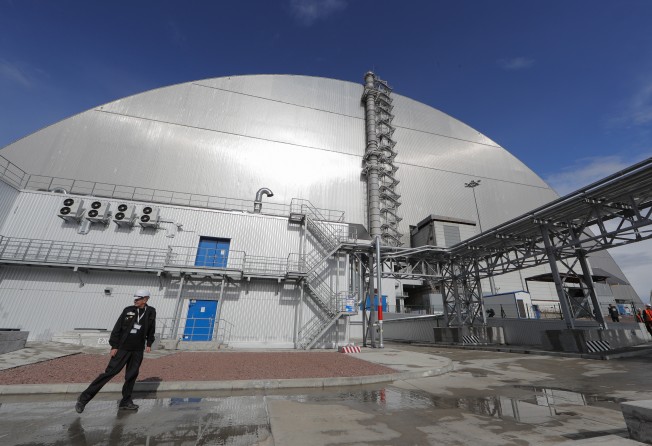
Chernobyl’s new US$1.7 billion radioactive dust shelter unveiled in Ukraine
- Giant structure was built to confine dangerous debris at the site of the 1986 nuclear reactor explosion
- Complex construction effort to secure the molten reactor’s core and 200 tonnes of highly radioactive material took nine years to complete

Ukraine’s President Volodymyr Zelensky on Wednesday inaugurated a giant structure built to confine radioactive debris at the nuclear reactor that exploded in Chernobyl in 1986.
The confinement structure for the Chernobyl nuclear power plant’s Reactor No 4 cost €1.5 billion (US$1.7 billion) to build, and the entire project cost €2.2 billion (US$2.5 billion).

The complex construction effort to secure the molten reactor’s core and 200 tonnes of highly radioactive material took nine years to complete under the auspices of the European Bank for Reconstruction and Development.
Officials have described the shelter as the largest movable land-based structure ever built, with a span of 257 metres (843 feet) and a total weight of over 36,000 tonnes.
Reactor No 4 at the plant in what was then Soviet Ukraine exploded and burned on April 26, 1986, spewing radioactive dust across Europe in the world’s worst nuclear accident.
Thirty workers died either from the explosion or from acute radiation sickness within several months. About 600,000 people had exposure to radiation at elevated levels while fighting the fire at the plant or working to clean up the contamination.
The accident exposed millions in the region to dangerous levels of radiation and forced a permanent evacuation of about 350,000 people from hundreds of towns and villages in Ukraine and Belarus.
The disaster’s eventual death toll has been subject to speculation and dispute, but the World Health Organisation’s cancer research arm has estimated that 9,000 people were to die of exposure-related cancer and leukaemia if Chernobyl disaster’s health effects follow a similar pattern to the Hiroshima and Nagasaki atomic bombings.

The new confinement structure was designed to safeguard radioactive debris and prevent further crumbling of the reactor. A section of the machine hall collapsed in 2012.
To finance the containment structure, the EBRD managed a fund with contributions from 45 countries, the European Union and the bank’s own resources. Ukraine contributed €100 million (US$112 million).
Deputy project manager Victor Zalizetskyi, who has been part of construction and repairs at the Chernobyl plant since 1987, said he was “filled with pride” that he got to work on a job “that has such a big importance for all humankind”.
However, Zalizetskyi expressed concern in an interview last week that war-torn Ukraine might struggle to cover the maintenance costs for the reactor’s new enclosure. He noted that costly and complicated work such as dismantling unstable sections of the power plant still needs to be done.
“It looks like Ukraine will be left alone to deal with this structure,” he said. “The work is not done yet, and we need to think about how to finance this project in the future.”
Zelensky promised on Wednesday that Ukraine would offer broader access to Chernobyl to scientists, environmental experts and tourists. “Chernobyl is a unique place on the planet where nature is reviving after a major technological catastrophe,” he said.